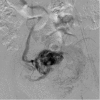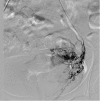Uterine Arteriovenous Malformation: Case Series and Literature Review
- PMID: 27382223
- PMCID: PMC4912488
- DOI: 10.1007/s13224-015-0680-2
Uterine Arteriovenous Malformation: Case Series and Literature Review
Abstract
Background: Uterine AV malformation is a rare cause of torrential post-abortal hemorrhage, which can present with varying grades of severity. Diagnosis requires a high degree of suspicion and is done with ultrasound and Doppler.
Case series: In our institution, during the period 2008-2013, five cases of symptomatic uterine AVMs have been reported. All of them were in the reproductive age group (22-36 years), presenting with a history of miscarriage or termination of pregnancy for which curettage was done. The presentation was with recurrent bouts of torrential bleeding, some triggered by second curettage, and not controllable with regular measures. Diagnosis was by ultrasound-gray scale, color Doppler, and spectral Doppler. The time interval between the onset of symptoms and the primary curettage was 8-89 days; four patients underwent selective arterial embolization, and one patient opted for hysterectomy. On follow-up, all the four patients are presently free of symptoms; two of them conceived within 2 years of the procedure and carried the pregnancy to term-one resulting in a live-birth and the other intrauterine death.
Conclusion: Uterine AV malformation should be thought of as a differential diagnosis in all cases presenting with bleeding after miscarriage or curettage, since diagnosis is simple and treatment by selective arterial embolization saves morbidity of surgery and anesthesia, and more importantly reduces hospital stay and the absence from work.
Keywords: Arteriovenous malformation; Gelfoam; Uterine artery embolization; Vascular malformations.
Figures







Similar articles
-
Ultrasound diagnosis and management of acquired uterine enhanced myometrial vascularity/arteriovenous malformations.Am J Obstet Gynecol. 2016 Jun;214(6):731.e1-731.e10. doi: 10.1016/j.ajog.2015.12.024. Epub 2016 Feb 9. Am J Obstet Gynecol. 2016. PMID: 26873276
-
Acquired uterine arteriovenous malformation following dilation and curettage: a case report.Pan Afr Med J. 2022 May 26;42:71. doi: 10.11604/pamj.2022.42.71.35371. eCollection 2022. Pan Afr Med J. 2022. PMID: 36034014 Free PMC article.
-
Use of three-dimensional power Doppler sonography in the diagnosis of uterine arteriovenous malformation and follow-up after uterine artery embolization: Case report and brief review of literature.J Clin Ultrasound. 2015 Jun;43(5):327-34. doi: 10.1002/jcu.22210. Epub 2014 Jul 18. J Clin Ultrasound. 2015. PMID: 25042165 Review.
-
Use of hysteroscopy in diagnosis and follow-up of acquired uterine enhanced myometrial vascularity.Fertil Steril. 2020 Feb;113(2):460-462. doi: 10.1016/j.fertnstert.2019.11.006. Fertil Steril. 2020. PMID: 32106997
-
Transcatheter embolization of uterine arteriovenous malformation: report of 2 cases and review of literature.J Minim Invasive Gynecol. 2011 Nov-Dec;18(6):812-9. doi: 10.1016/j.jmig.2011.07.007. J Minim Invasive Gynecol. 2011. PMID: 22024270 Review.
Cited by
-
Our Experience in Using the Endovascular Therapy in the Management of Hemorrhages in Obstetrics and Gynecology.Diagnostics (Basel). 2022 Jun 10;12(6):1436. doi: 10.3390/diagnostics12061436. Diagnostics (Basel). 2022. PMID: 35741246 Free PMC article.
-
Successful management of intraoperative cesarean section bleeding due to cervical arteriovenous malformation: A case report.Case Rep Womens Health. 2024 Nov 19;44:e00667. doi: 10.1016/j.crwh.2024.e00667. eCollection 2024 Dec. Case Rep Womens Health. 2024. PMID: 40017911 Free PMC article.
-
Postabortal Bleeding: A Diagnostic Dilemma Resolved As Arteriovenous Malformation and Successfully Managed With Uterine Artery Embolization.Cureus. 2023 Nov 29;15(11):e49666. doi: 10.7759/cureus.49666. eCollection 2023 Nov. Cureus. 2023. PMID: 38161858 Free PMC article.
-
Sonographic Features of Uterine Arteriovenous Malformation: A Case Series.Diagnostics (Basel). 2024 Apr 23;14(9):873. doi: 10.3390/diagnostics14090873. Diagnostics (Basel). 2024. PMID: 38732288 Free PMC article.
-
Neovasculature can be induced by patching an arterial graft into a vein: A novel in vivo model of spontaneous arteriovenous fistula formation.Sci Rep. 2018 Feb 16;8(1):3156. doi: 10.1038/s41598-018-21535-2. Sci Rep. 2018. PMID: 29453407 Free PMC article.
References
-
- O’Brien P, Neyastani A, Buckley AR, et al. Uterine Arteriovenous malformations—from diagnosis to treatment. J Ultrasound Med. 2006;25:1387–1392. - PubMed
-
- Tullio G, Susanna G, Cristina R, et al. Three dimensional Power Doppler sonography in the diagnosis of arteriovenous malformation of the uterus. J Ultrasound Med. 2005;24:727–731. - PubMed
LinkOut - more resources
Full Text Sources
Other Literature Sources
